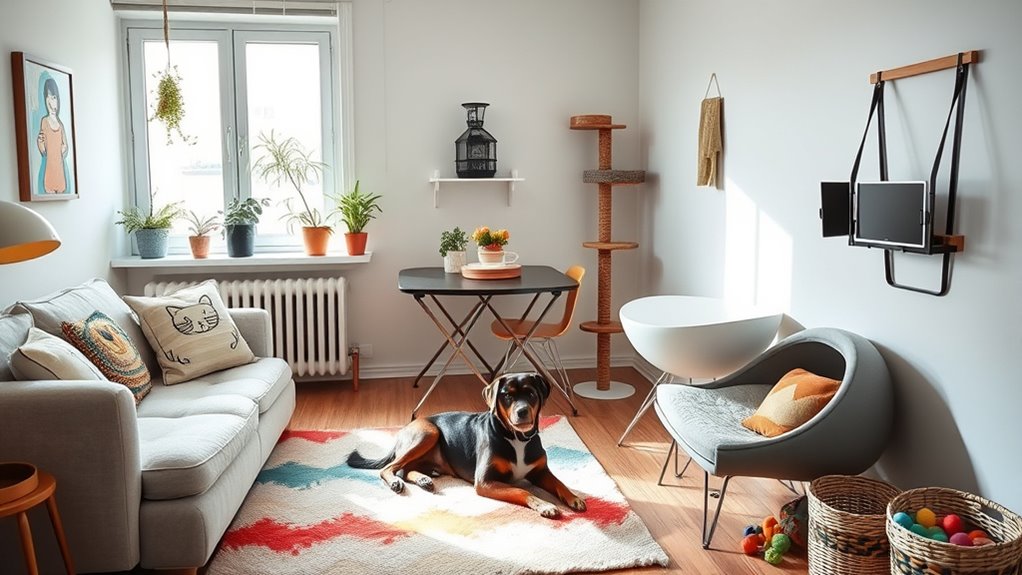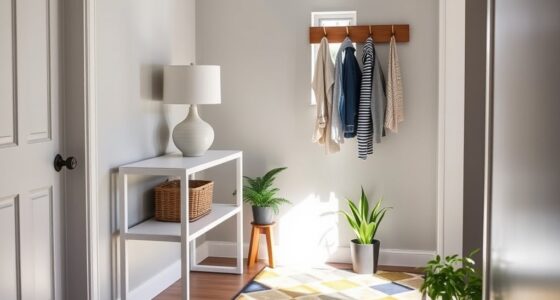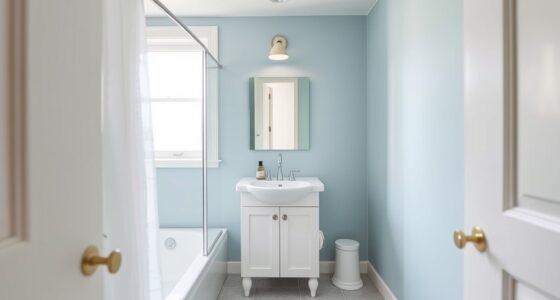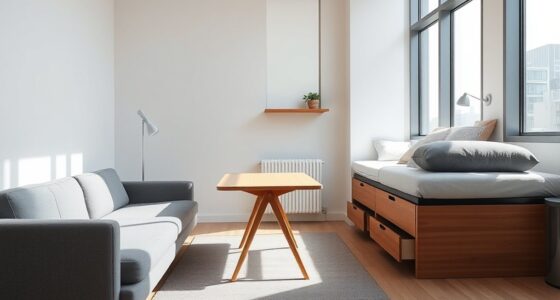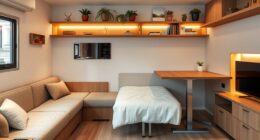To design a pet-friendly small apartment, you should create a dedicated pet zone with cozy beds and toys, maximize vertical and hidden storage with shelves and multifunctional furniture, and choose durable, easy-to-clean materials like vinyl floors and stain-resistant fabrics. Incorporate safe play areas with climbing structures and soft padding, organize supplies with labeled bins, and add cozy retreats and stimulation zones for your pet’s comfort. Keep exploring how to make your space both functional and welcoming for your furry friends.
Key Takeaways
- Create designated pet zones with cozy beds, toys, and feeding areas to maximize comfort and organization.
- Utilize vertical space with wall-mounted shelves, climbing structures, and wall niches to save floor area.
- Choose durable, easy-to-clean materials like vinyl flooring and stain-resistant fabrics for furniture and surfaces.
- Incorporate hidden storage solutions and multi-purpose furniture to keep clutter minimal and optimize space.
- Add stimulating elements such as puzzle feeders, sensory mats, and window perches for enrichment in small spaces.
Creating a Dedicated Pet Zone
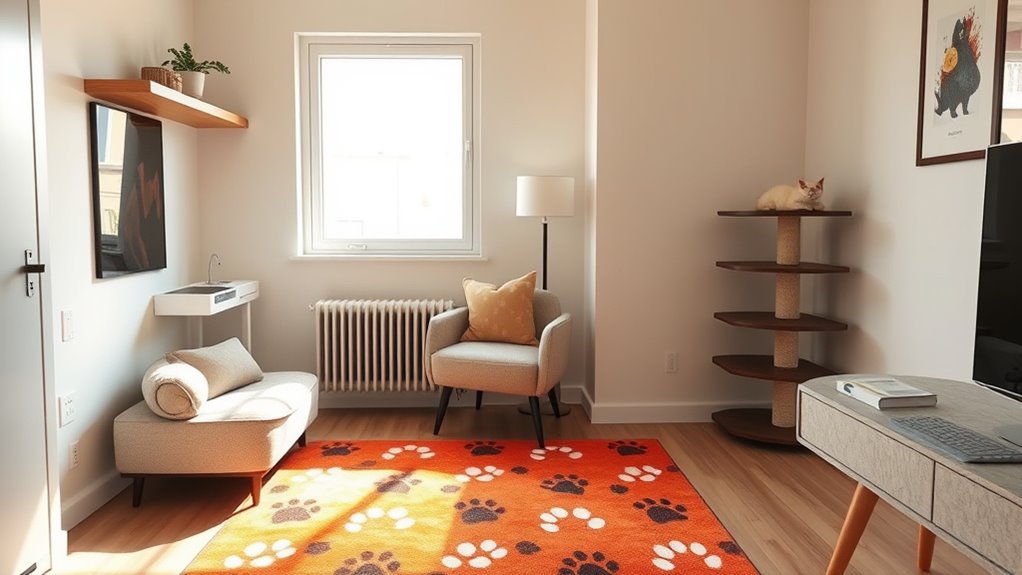
Have you considered designating a specific area in your apartment for your pet? Creating a dedicated pet zone keeps everything organized and accessible. Focus on a quiet, low-traffic corner to ensure your pet feels secure. Use a cozy bed, food bowls, and toys within this space to make it inviting. Incorporate compact, multifunctional furniture like storage ottomans or benches that serve as both seating and storage. Vertical elements such as wall-mounted shelves or climbing platforms maximize space and give your pet elevated resting spots. Choose durable, easy-to-clean materials for the pet zone to simplify upkeep. Using self watering plant pots can help maintain indoor plants with minimal maintenance, adding a calming natural element to your pet area. Incorporating smart home technology can further enhance the environment by allowing you to monitor and control temperature, lighting, and air quality remotely, ensuring your pet’s comfort and safety. This not only enhances the ambiance but also helps keep the space organized and stress-free. By establishing a dedicated pet area, you provide your furry friend with a secure, comfortable environment while maintaining a tidy and functional living space for yourself.
Maximizing Vertical and Hidden Spaces
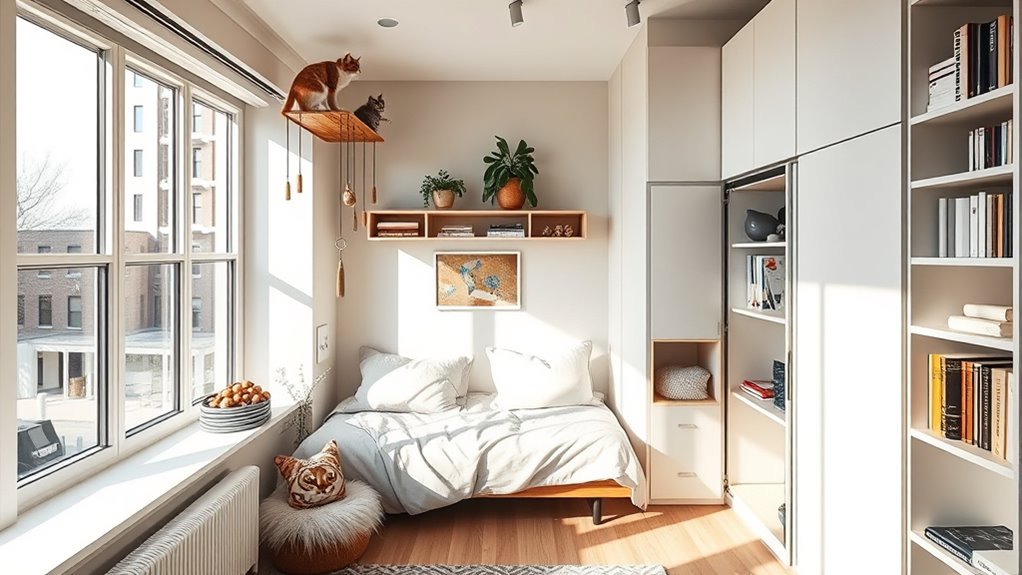
Building on your pet zone, maximizing vertical and hidden spaces helps keep your apartment organized and pet-friendly. Use floating shelves and wall-mounted platforms to create vertical zones where pets can perch, rest, or observe without taking up floor space. Incorporate wall niches or behind cabinetry for concealed storage, hiding pet beds, litter boxes, and toys to reduce clutter. Add vertical climbing structures like wall-mounted cat trees or shelves to promote exercise and enrichment, making full use of unused wall height. Consider multi-level furniture, such as beds on raised platforms or storage benches with hidden compartments, to serve dual purposes for you and your pets. Secure and reinforce wall-mounted features to ensure safety, allowing your pets to explore elevated areas confidently in your small space. Incorporating spatial awareness] into your design ensures safety and maximizes functionality. Additionally, understanding pinball machine weight can be useful if you plan to incorporate vintage or heavy furniture pieces inspired by game rooms into your home decor.
Choosing Durable and Easy-to-Clean Materials
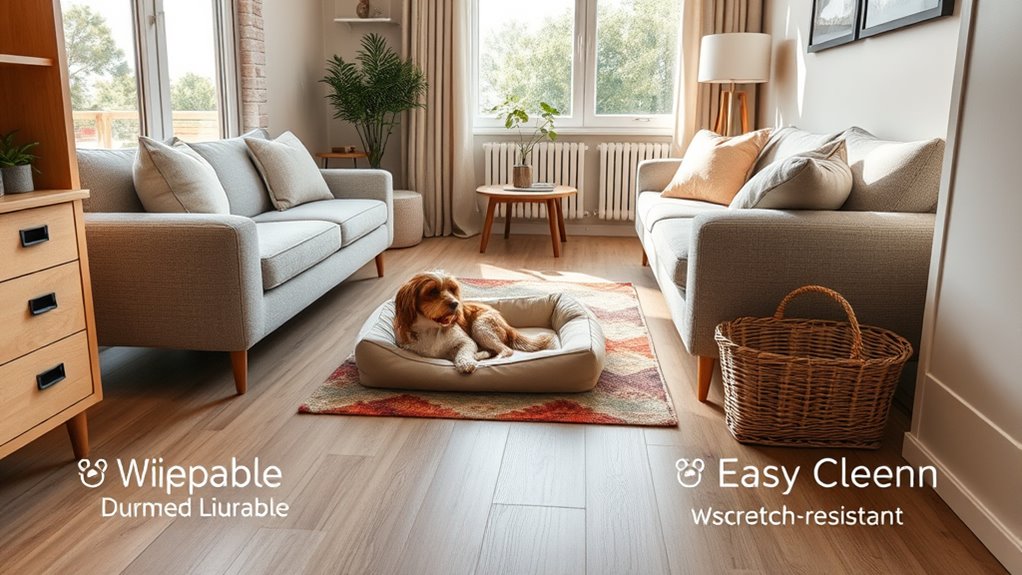
Choosing durable, easy-to-clean materials is essential for a pet-friendly apartment. Opt for scratch-resistant surfaces and fabrics that can handle claws, fur, and frequent cleaning. Incorporating long-term partnership strategies in your space maintenance can also help ensure your home remains comfortable and functional for both you and your pet. These choices help you maintain a tidy space while protecting your furniture and surfaces from pet-related damage. Being aware of regional legal resources can also be beneficial if any disputes or issues arise related to pet ownership and housing regulations. Additionally, selecting materials that align with ancient wisdom about harmony and balance can promote a more peaceful environment for all inhabitants. Considering natural materials can further enhance the sustainability and aesthetic appeal of your space.
Scratch-Resistant Surfaces
Selecting scratch-resistant surfaces is essential for maintaining a small, pet-friendly apartment, as pets can easily cause damage to delicate materials. Choosing durable options helps keep your space looking fresh without sacrificing style or comfort.
For example, you’re less likely to see scratches on surfaces like quartz countertops, luxury vinyl flooring, or bamboo flooring, which are perfect for a small apartment. These materials are easy to clean and resist pet hair, making them ideal for the living room. Additionally, understanding color accuracy can help you select materials and finishes that maintain their appearance over time despite pet activity.
To match your specific needs:
- Opt for ceramic or porcelain tiles in high-traffic pet zones
- Use scratch-proof cabinetry with laminated or sealed surfaces
- Choose microfiber or microsuede upholstery for furniture
- Make sure paint finishes are semi-gloss or satin for easy cleaning
These choices help keep your apartment functional and stylish while staying active with your pet.
Easy-to-Maintain Fabrics
When outfitting your small apartment for pet life, focusing on fabrics that are easy to maintain can save you time and effort. Choose materials like microfiber, microsuede, or polyester blends, which resist stains, pet hair, and scratches. Selecting fabrics designed for durability can further enhance your pet-friendly space by ensuring long-lasting comfort and easy cleaning. These fabrics are often treated with protective coatings that help repel liquids and dirt, making them even more suitable for active pet environments. Additionally, opting for fabrics with antimicrobial properties can help reduce odors and inhibit bacterial growth, maintaining a fresher space. Slipcovers and rugs labeled as machine washable make cleanup after accidents or shedding simple. Opt for durable, tight-weave carpets that prevent nail snagging and trap less dirt, easing maintenance. Furthermore, choosing low-pile fabrics reduces fur buildup and makes vacuuming more efficient. Fabrics with a low pile height improve cleanliness by minimizing trapped hair and debris, making regular upkeep less burdensome. Moreover, selecting materials that are water- and stain-resistant can significantly extend furniture lifespan and simplify daily maintenance. Incorporating these durable and easy-to-clean fabrics can also contribute to positive thinking, reducing stress and creating a more harmonious pet-friendly environment.
Incorporating Multi-Functional Furniture
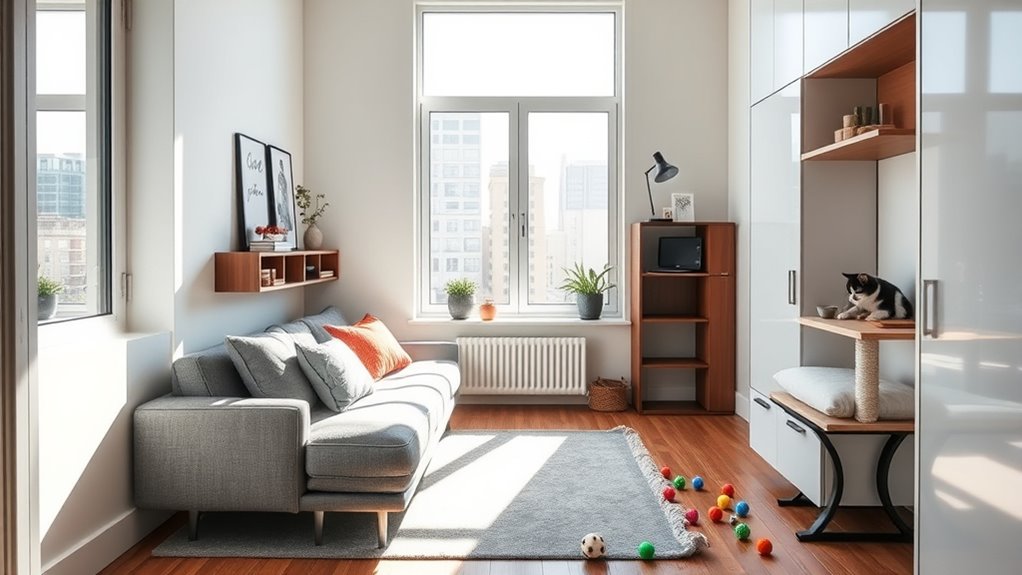
In small apartments, incorporating multi-functional furniture is essential for maximizing space and maintaining a tidy environment. It helps you save room while keeping everything organized for your pet’s comfort. For example, ottomans with hidden storage keep pet toys and supplies out of sight but easily accessible. Benches with built-in cubbies serve as both seating and cozy spots for your pet to rest. Combining seating with integrated feeding stations creates a seamless look and keeps essentials close at hand. Multi-purpose furniture also reduces clutter by consolidating pet items, freeing up valuable floor space. When choosing pieces, opt for durable, pet-friendly materials to ensure longevity and easy cleaning. Additionally, incorporating float mounting textile art techniques can inspire creative ways to decorate your space with personalized, lightweight art pieces that are easy to change out. This approach aligns with space optimization principles, making your small apartment functional, stylish, and pet-friendly. Using multi-functional furniture can further enhance your space by serving multiple purposes without sacrificing style or comfort. To ensure safety and suitability, consider pet-safe materials when selecting furniture to prevent accidents or damage. Furthermore, selecting furniture with adjustable components allows you to adapt pieces as your pet grows or your needs change.
Organizing Pet Supplies and Clutter Control
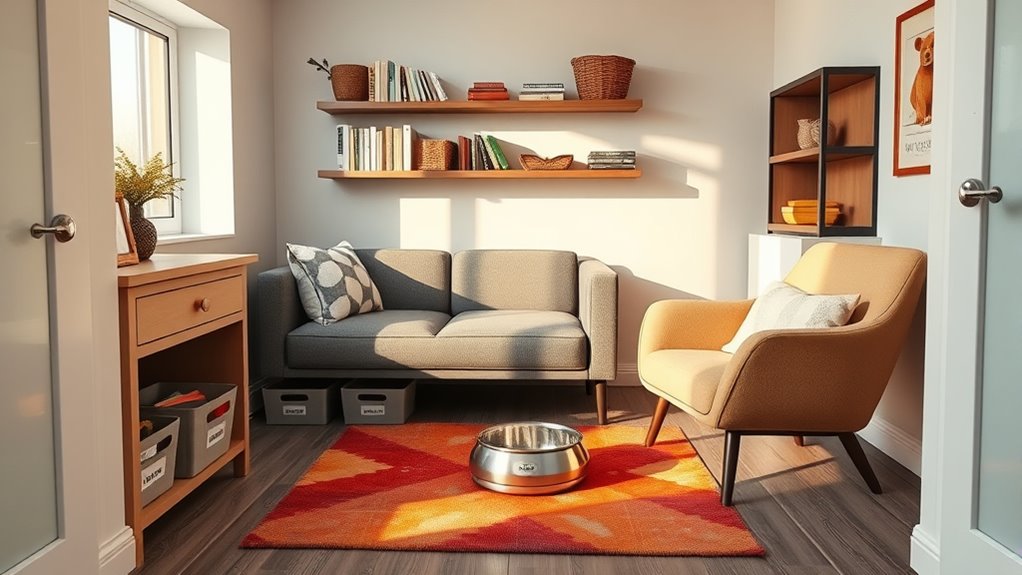
Organizing pet supplies effectively can considerably reduce clutter and make daily routines smoother. Use labeled, multi-compartment storage bins and wall-mounted hooks to keep items like leashes, toys, and grooming tools accessible yet tidy. Incorporate dedicated furniture, such as ottomans with hidden compartments or benches with built-in cubbies, to conceal clutter and save space. Designate specific zones in cabinets or closets for different supplies, which helps prevent chaos and streamlines your pet’s essentials. Opt for stackable, space-saving containers to maximize limited space and keep supplies from spreading throughout your apartment. Regularly declutter and rotate your pet’s belongings to avoid unnecessary accumulation. Additionally, selecting Pimple Patches that are discreet and easy to remove can help maintain a tidy space without adding visual clutter. Maintaining this routine ensures your small apartment remains organized, functional, and welcoming for both you and your furry friend.
Designing Safe and Stimulating Play Areas
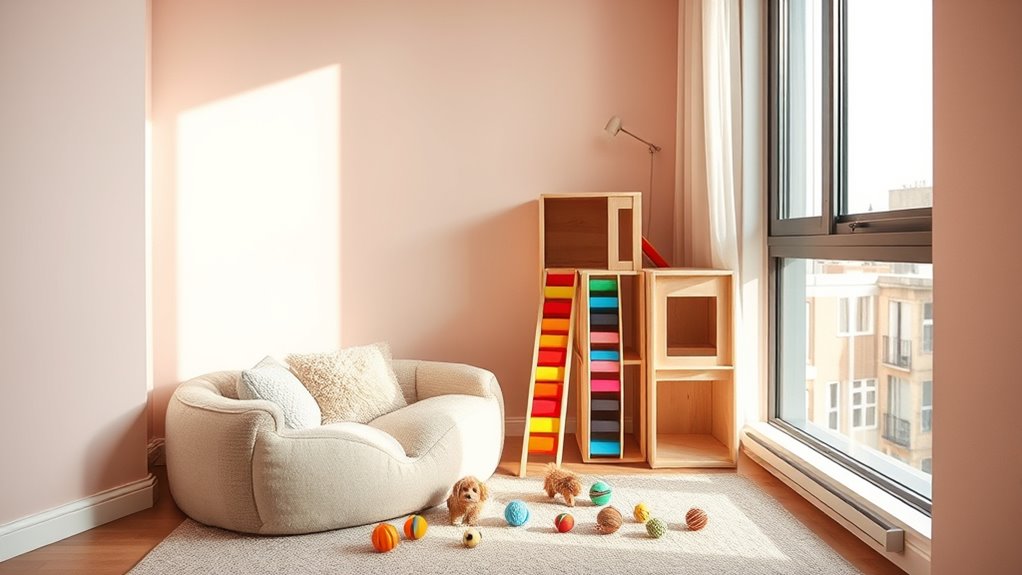
When designing play areas, focus on safety by choosing non-slip flooring and scratch-resistant surfaces that can withstand active pets.
Incorporate climbing structures and wall-mounted shelves at different heights to encourage movement and mental stimulation without taking up floor space.
Adding interactive toys and proper lighting makes the space inviting and engaging, promoting healthy activity and exploration.
Safe Play Zone Design
Creating a safe and stimulating play zone in a small apartment requires thoughtful design to keep your pet both entertained and protected. Focus on materials and layout that prevent accidents and encourage activity.
Use non-slip, durable flooring like rubber mats or textured tiles to avoid slips and withstand play.
Design enclosed or raised areas with sturdy barriers so your pet can explore freely without falling or escaping.
Incorporate hidden or low-lying storage for toys and accessories to keep clutter at bay and prevent tripping hazards.
Use rounded-edge furniture and soft padding around play zones to minimize injuries from bumps or falls.
Additionally, integrate vertical structures like wall-mounted shelves or ramps, securely anchored, to promote safe climbing and mental stimulation.
Enrichment and Activity Options
Incorporating vertical enrichment options like wall-mounted climbing systems and multi-level platforms can substantially enhance your pet’s play area while conserving floor space. These features satisfy natural climbing instincts and keep your pet active.
Design designated play zones with interactive toys, puzzle feeders, and sensory mats to stimulate mental engagement and reduce boredom.
Use durable, non-toxic materials for flooring and furniture within these areas to guarantee safety and make cleaning easier after energetic play sessions.
Additionally, create secluded or hidden nooks where your pet can retreat for comfort and stress relief during busy household moments.
Installing adjustable or removable barriers allows your pet to explore different zones safely while maintaining control and preventing accidents.
These options foster a stimulating, safe environment suited for small apartment living.
Enhancing Comfort With Cozy Retreats
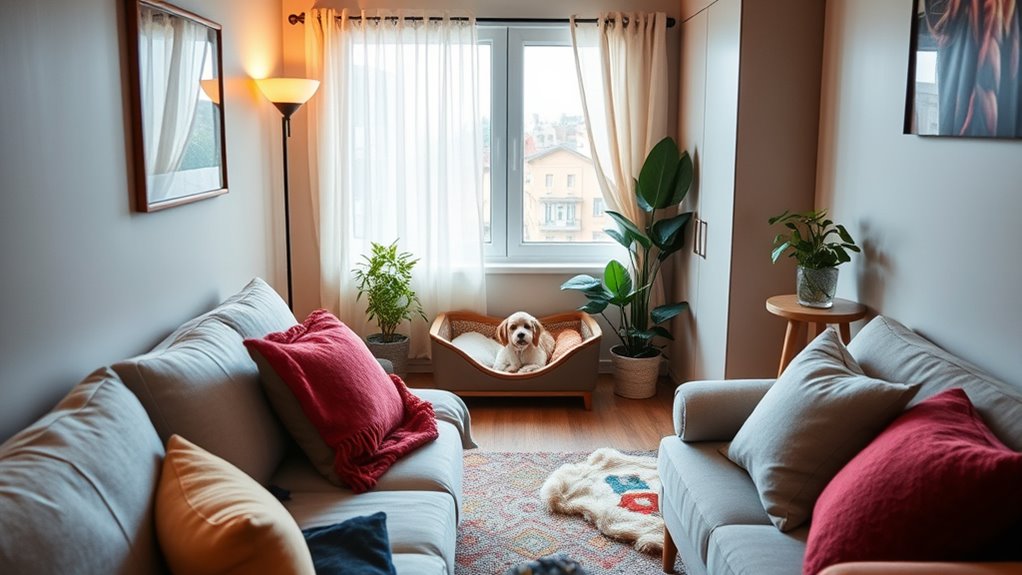
To enhance your small apartment’s comfort for your pet, designing a cozy retreat is essential. Choose a quiet corner with soft bedding and calming colors to encourage relaxation.
Create a cozy corner with soft bedding and soothing colors for your pet’s ultimate relaxation.
Add soundproofing elements like plush curtains or rugs to reduce noise and create a peaceful space.
Use multifunctional furniture, such as a storage ottoman with a hidden pet bed, to maximize space and provide a comforting hideaway.
Position a window perch or a cozy nook near natural light so your pet can observe their surroundings and feel secure.
Incorporate calming scents like lavender or chamomile in the area to help reduce stress and promote tranquil rest.
This retreat becomes a safe haven where your pet can unwind and feel at ease in your small apartment.
Frequently Asked Questions
What Is the Best Pet to Have in a Small Apartment?
When choosing the best pet for a small apartment, consider your lifestyle and space.
Cats are ideal because they’re independent and don’t need much room.
Small dog breeds like French Bulldogs or Dachshunds adapt well to limited space.
Small mammals, fish, or reptiles also make great pets since they require minimal space and maintenance.
You’ll want a pet that fits your living situation and your ability to care for it comfortably.
What Is the Minimum Apartment Size for a Dog?
The minimum apartment size for a dog depends on its breed and activity level. For small breeds, aim for at least 100 to 150 square feet.
Larger or more active dogs need 200 square feet or more.
In smaller spaces under 300 square feet, you can still accommodate your pet with clever design features.
How Do You Get Around Pet Restrictions in an Apartment?
When facing pet restrictions in an apartment, you should first review your lease for specific rules and fees.
Then, talk openly with management about your pet, sharing good behavior and vaccination proof.
You can also suggest soundproofing or safety measures to ease concerns.
If restrictions remain strict, consider alternative housing options like pet-friendly rentals, co-living spaces, or properties with more flexible lease terms that welcome pets.
Is It Okay to Have a Dog in a Small Apartment?
Having a dog in a small apartment isn’t just okay, it’s entirely feasible and can be incredibly rewarding!
With the right routines, you can make certain your pup stays happy, healthy, and stress-free. Choose smaller breeds, set boundaries, and create designated space for play and rest.
Regular outdoor walks and mental stimulation will keep your dog thriving in a limited space, proving that size isn’t everything when it comes to pet happiness.
Conclusion
By incorporating these pet-friendly design tips, you turn your small apartment into a haven where your furry friend feels safe and loved. Think of your space as a puzzle, with each piece fitting perfectly to create harmony and happiness. When you prioritize durability, organization, and comfort, you craft an environment where both you and your pet thrive. With a little creativity, your tiny apartment becomes a spacious playground filled with love and endless adventures.
